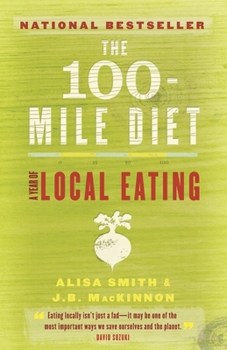The 100-Mile Diet: A Year of Local Eating
Select Format
Select Condition 
Book Overview
The remarkable, amusing and inspiring adventures of a Canadian couple who make a year-long attempt to eat foods grown and produced within a 100-mile radius of their apartment. When Alisa Smith and James MacKinnon learned that the average ingredient in a North American meal travels 1,500 miles from farm to plate, they decided to launch a simple experiment to reconnect with the people and places that produced what they ate. For one year, they would only consume food that came from within a 100-mile radius of their Vancouver apartment. The 100-Mile Diet was born. The couple's discoveries sometimes shook their resolve. It would be a year without sugar, Cheerios, olive oil, rice, Pizza Pops, beer, and much, much more. Yet local eating has turned out to be a life lesson in pleasures that are always close at hand. They met the revolutionary farmers and modern-day hunter-gatherers who are changing the way we think about food. They got personal with issues ranging from global economics to biodiversity. They called on the wisdom of grandmothers, and immersed themselves in the seasons. They discovered a host of new flavours, from gooseberry wine to sunchokes to turnip sandwiches, foods that they never would have guessed were on their doorstep. The 100-Mile Diet struck a deeper chord than anyone could have predicted, attracting media and grassroots interest that spanned the globe. The 100-Mile Diet: A Year of Local Eating tells the full story, from the insights to the kitchen disasters, as the authors transform from megamart shoppers to self-sufficient urban pioneers. The 100-Mile Diet is a pathway home for anybody, anywhere. Call me naive, but I never knew that flour would be struck from our 100-Mile Diet. Wheat products are just so ubiquitous, "the staff of life," that I had hazily imagined the stuff must be grown everywhere. But of course: I had never seen a field of wheat anywhere close to Vancouver, and my mental images of late-afternoon light falling on golden fields of grain were all from my childhood on the Canadian prairies. What I was able to find was Anita's Organic Grain & Flour Mill, about 60 miles up the Fraser River valley. I called, and learned that Anita's nearest grain suppliers were at least 800 miles away by road. She sounded sorry for me. Would it be a year until I tasted a pie?
--From The 100-Mile Diet
--From The 100-Mile Diet
Format:Paperback
Language:English
ISBN:0679314830
ISBN13:9780679314837
Release Date:October 2007
Publisher:Vintage Books Canada
Length:288 Pages
Weight:0.69 lbs.
Dimensions:0.8" x 5.3" x 8.0"
Customer Reviews
2 ratings
Loved this book!
Published by Thriftbooks.com User , 16 years ago
I loved this book. I think it's a must read for anyone who is interested in local eating because it debunks the myth that it's impossible for people in northern climates. If you are interested in becoming a "locavore", I suggest reading this book along with "Animal, Vegetable, Mineral" by Barbara Kingsolver, "Omnivore's Dilemma" by Michael Pollan, and "Full Moon Feast" by Jessica Prentice. The problem I had with the other books is that I found them to be negative towards vegetarians and vegans. So you can imagine my excitement when I found out that Alisa Smith and J.B. MacKinnon were vegetarians! However, they gave that up before beginning the project. That was really disappointing to me and I would have liked this book more if they had at least given it an honest try before eating meat. That's why I give it 4 stars instead of 5. Otherwise, a good and fun read.
A truly inspirational read
Published by Thriftbooks.com User , 17 years ago
This very personal account is a very inspiring and motivational book. While reading this, I couldn't stop telling people about the ideas, the stories and the passion of what i was reading. I checked the local farm market schedule midway through the book and am very excited to be going this week. I think some other people are missing the point. This book isn't trying to convert everyone to a local diet. They don't always make the most environmentally friendly decisions, but it's the connection with the food and where it comes from, that's what is the moral of this story. Between knowing your own fisherman, to making your own salt... to just knowing the season of what is fresh and local. The simple concept of 'who knows what asparagus season is' hit home... and I immediately downloaded the local crops information. Too often, we are trying to cut spending and we hurt for it. Paying good money for good food is something definately worthwhile. I'm not going to pickle my vegetables, and live on beets for the winter... but it's a story that really makes me question what I'm eating, and where it comes from. Consequently, I haven't been to a fast food place since reading this. Much better of an argument for me than fast food nation, or supersize this. The was truly a gem.






